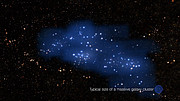Comparison of the Hyperion Proto-Supercluster and a standard massive galaxy cluster
Wide-field view of the COSMOS field
Videos
ESOcast 179 Light: Largest Galaxy Proto-Supercluster Found (4K UHD)
The team found that Hyperion has a very complex structure, containing at least 7 high-density regions connected by filaments of galaxies, and its size is comparable to nearby superclusters, though it has a very different structure.
“Superclusters closer to Earth tend to a much more concentrated distribution of mass with clear structural features,”
explains Brian Lemaux, an astronomer from University of California,
Davis and LAM, and a co-leader of the team behind this result. “But
in Hyperion, the mass is distributed much more uniformly in a series of
connected blobs, populated by loose associations of galaxies.”
This contrast is most likely due to the fact that nearby
superclusters have had billions of years for gravity to gather matter
together into denser regions — a process that has been acting for far
less time in the much younger Hyperion.
Given its size so early in the history of the Universe,
Hyperion is expected to evolve into something similar to the immense
structures in the local Universe such as the superclusters making up the
Sloan Great Wall or the Virgo Supercluster that contains our own galaxy, the Milky Way. “Understanding
Hyperion and how it compares to similar recent structures can give
insights into how the Universe developed in the past and will evolve
into the future, and allows us the opportunity to challenge some models
of supercluster formation,” concluded Cucciati. “Unearthing this cosmic titan helps uncover the history of these large-scale structures.”
Notes
[1] The moniker Hyperion was chosen after a Titan from Greek mythology,
due to the immense size and mass of the proto-supercluster. The
inspiration for this mythological nomenclature comes from a previously
discovered proto-cluster found within Hyperion and named Colossus. The
individual areas of high density in Hyperion have been assigned
mythological names, such as Theia, Eos, Selene and Helios, the latter being depicted in the ancient statue of the Colossus of Rhodes.
The titanic mass of Hyperion, one million billion times that of the Sun, is 1015 solar masses in scientific notation.
[2] Light reaching Earth
from extremely distant galaxies took a long time to travel, giving us a
window into the past when the Universe was much younger. This wavelength
of this light has been stretched by the expansion of the Universe over
its journey, an effect known as cosmological redshift. More distant,
older objects have a correspondingly larger redshift, leading
astronomers to often use redshift and age interchangeably. Hyperion’s
redshift of 2.45 means that astronomers observed the proto-supercluster
as it was 2.3 billion years after the Big Bang.
More Information
Contacts
Olga Cucciati
INAF Fellow – Osservatorio di Astrofisica e Scienza dello Spazio di Bologna
Bologna, Italy
Email: olga.cucciati@inaf.it
Calum Turner
ESO Public Information Officer
Garching bei München, Germany
Tel: +49 89 3200 6670
Email: pio@eso.org
More Information
This research is
published in the paper “The progeny of a Cosmic Titan: a massive
multi-component proto-supercluster in formation at z=2.45 in VUDS”,
which will appear in the journal Astronomy & Astrophysics.
The team behind this result was composed of O. Cucciati
(INAF-OAS Bologna, Italy), B. C. Lemaux (University of California,
Davis, USA and LAM - Aix Marseille Université, CNRS, CNES, France), G.
Zamorani (INAF-OAS Bologna, Italy), O.Le Fèvre (LAM - Aix Marseille
Université, CNRS, CNES, France), L. A. M. Tasca (LAM - Aix Marseille
Université, CNRS, CNES, France), N. P. Hathi (Space Telescope Science
Institute, Baltimore, USA), K-G. Lee (Kavli IPMU (WPI), The University
of Tokyo, Japan, & Lawrence Berkeley National Laboratory, USA), S.
Bardelli (INAF-OAS Bologna, Italy), P. Cassata (University of Padova,
Italy), B. Garilli (INAF–IASF Milano, Italy), V. Le Brun (LAM - Aix
Marseille Université, CNRS, CNES, France), D. Maccagni (INAF–IASF
Milano, Italy), L. Pentericci (INAF–Osservatorio Astronomico di Roma,
Italy), R. Thomas (European Southern Observatory, Vitacura, Chile), E.
Vanzella (INAF-OAS Bologna, Italy), E. Zucca (INAF-OAS Bologna, Italy),
L. M. Lubin (University of California, Davis, USA), R. Amorin (Kavli
Institute for Cosmology & Cavendish Laboratory, University of
Cambridge, UK), L. P. Cassarà (INAF–IASF Milano, Italy), A. Cimatti
(University of Bologna & INAF-OAS Bologna, Italy), M. Talia
(University of Bologna, Italy), D. Vergani (INAF-OAS Bologna, Italy), A.
Koekemoer (Space Telescope Science Institute, Baltimore, USA), J. Pforr
(ESA ESTEC, the Netherlands), and M. Salvato (Max-Planck-Institut für
Extraterrestrische Physik, Garching bei München, Germany).
ESO is the foremost intergovernmental astronomy
organisation in Europe and the world’s most productive ground-based
astronomical observatory by far. It has 16 Member States: Austria,
Belgium, the Czech Republic, Denmark, France, Finland, Germany, Italy,
the Netherlands, Poland, Portugal, Spain, Sweden, Switzerland and the
United Kingdom, along with the host state of Chile and with Australia as
a strategic partner. ESO carries out an ambitious programme focused on
the design, construction and operation of powerful ground-based
observing facilities enabling astronomers to make important scientific
discoveries. ESO also plays a leading role in promoting and organising
cooperation in astronomical research. ESO operates three unique
world-class observing sites in Chile: La Silla, Paranal and Chajnantor.
At Paranal, ESO operates the Very Large Telescope and its world-leading
Very Large Telescope Interferometer as well as two survey telescopes,
VISTA working in the infrared and the visible-light VLT Survey
Telescope. ESO is also a major partner in two facilities on Chajnantor,
APEX and ALMA, the largest astronomical project in existence. And on
Cerro Armazones, close to Paranal, ESO is building the 39-metre
Extremely Large Telescope, the ELT, which will become “the world’s
biggest eye on the sky”.
Links
Links
Contacts
Olga Cucciati
INAF Fellow – Osservatorio di Astrofisica e Scienza dello Spazio di Bologna
Bologna, Italy
Email: olga.cucciati@inaf.it
Calum Turner
ESO Public Information Officer
Garching bei München, Germany
Tel: +49 89 3200 6670
Email: pio@eso.org
Source: ESO/News




